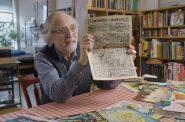Bruce Connor at INOVA
 In 1995, Bruce Conner compiled a list of terms used to describe him in connection with the Whitney Museum exhibition “Beat Culture and the New America, 1950-1965”:
In 1995, Bruce Conner compiled a list of terms used to describe him in connection with the Whitney Museum exhibition “Beat Culture and the New America, 1950-1965”:
“I am an artist, an anti-artist, no shrinking ego, modest, a feminist, a profound misogynist, a romantic, a realist, a surrealist, a funk artist, conceptual artist, minimalist, post-modernist, beatnik, hippie, punk, subtle, confrontational, believable, paranoiac, courteous, difficult, forthright, impossible to work with, accessible , obscure, precise, calm, contrary, elusive, spiritual, profane, a Renaissance man of contemporary art and one of the most important artists in the world. My work is described as beautiful, horrible, hogwash, genius, maundering, precise, quaint, avant-garde, historical, hackneyed, masterful, trivial, intense, mystical, virtuosic, bewildering, absorbing, concise, absurd, amusing, innovative, nostalgic, contemporary, iconoclastic, sophisticated, trash, masterpieces, etc.”
Conner was a purposefully enigmatic artist, and the current exhibition at Inova/Kenilworth isn’t so much a retrospective as it is an illustrative cross-section of themes and interests of his career. Subversive tendencies, which reflect his admiration for the Dadaist cleverness of artists like Marcel Duchamp, can be teased out of his project The Dennis Hopper One Man Show. The conception for this series began in the 1960s, created by Conner but purposefully misattributed to Hopper, a friend and fellow Kansas native with a keen interest in photography. The prints tend toward rugged subjects like nineteenth-century men climbing mountains, with the insertion of odd, unexpected objects. This surrealist aspect is woven throughout these works in the combinations of historical images combined with fragmentary flora, fauna, and figures.
In the center of the exhibition is a large vitrine filled with ephemera — letters, documents, and notes that shed light on the man behind the making of these works. A print of Conner’s birth certificate, his tiny footprints offering the stamp of authenticity, is something of a pendant to one of the show’s opening works, signed by Conner with the singular gesture of his thumbprint.
Showing concurrently in front gallery space is Psychotrope, an exhibition of seven artists working in video. The effect is carnivalesque, trippy, and even a little cacophonous despite the spacious setting of the works, which are placed around the gallery with seating and headphones for an individual experience. Abstraction is a common impulse, and the patterns of light and sound can seem to smudge the clarity of one’s senses. Shana Moulton is an exception with the narrative underpinnings of her vision quest-tinged Sand Saga (2008), a journey that leads us searching between the spa and the spirit.
Both exhibitions run through September 26, 2010 at Inova/Kenilworth, 2155 N. Prospect Ave. The UWM Union Theater (2200 Kenwood Blvd.) will host free screenings of Conner’s films on Tuesday, September 14 and September 21 at 7PM, with a talk by curator Bruce Jenkins at the September 21 screening.
Art
-
It’s Not Just About the Holidays
 Dec 3rd, 2024 by Annie Raab
Dec 3rd, 2024 by Annie Raab
-
After The Election Is Over
 Nov 6th, 2024 by Annie Raab
Nov 6th, 2024 by Annie Raab
-
The Spirit of Milwaukee
 Aug 30th, 2024 by Annie Raab
Aug 30th, 2024 by Annie Raab
Movies
-
Republican Legislators Push Tax Credits for Films Made in Wisconsin
 May 21st, 2025 by Baylor Spears
May 21st, 2025 by Baylor Spears
-
Mystery Movie Being Filmed in Milwaukee With Kevin Spacey
 Apr 24th, 2025 by Jeramey Jannene
Apr 24th, 2025 by Jeramey Jannene
-
Two Documentaries Offer Lessons in Fame
 Apr 24th, 2025 by Dominique Paul Noth
Apr 24th, 2025 by Dominique Paul Noth





















